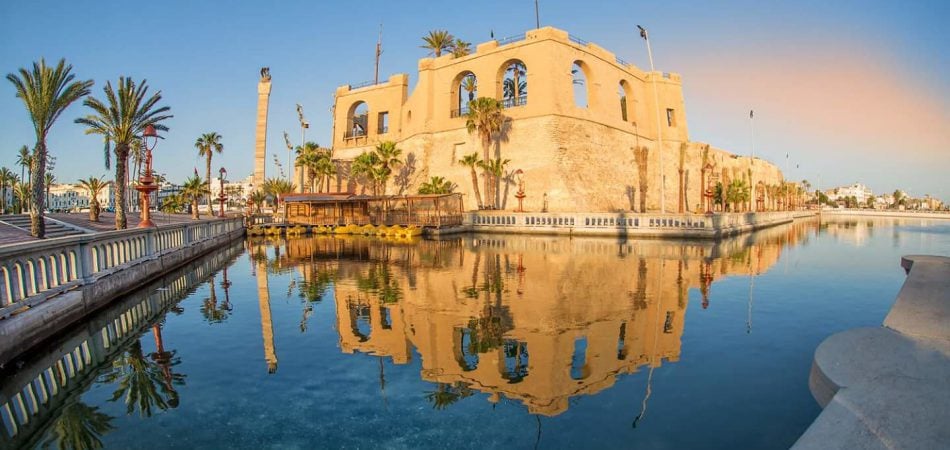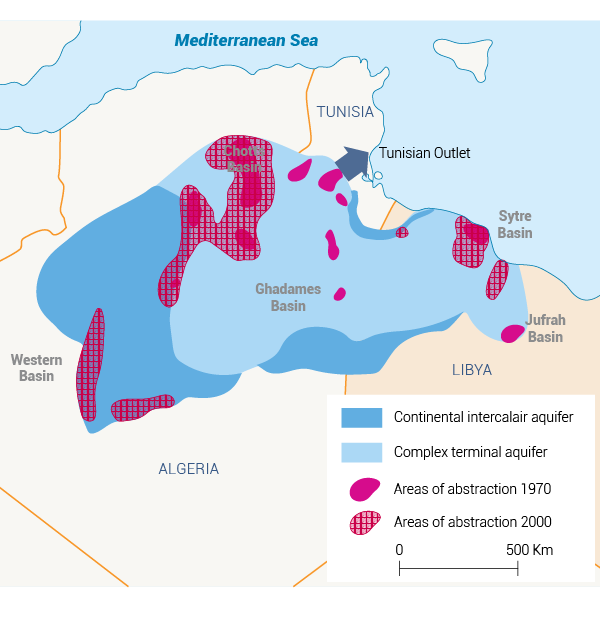
Transboundary aquifer management
Libya has no shared surface water but shares groundwater with several of its neighbours. The North Sahara Basin extends over an area of more than 1 million km2, of which 700,000 km2 are in Algeria, 60,000 km2 in Tunisia and 250,000 km2 in Libya.[1]
The fossil water of the deep aquifer, known as the Septentrional Saharan Aquifer System (SSAS), has two main deep aquifer layers: the continental interlayer and the shallower terminal complex (Map1).[2] The consultation system to manage the share of water resources is conducted under the management structure of the Sahara and Sahel Observatory in Tunis. This managing structure consists of representatives from the three countries.[3] [4]
Over the last three decades, 0.6 to 2.5 billion cubic metres (BCM) of water have been abstracted from the SSAS per year. This high rate of abstraction is leading to loss of the artesian condition, salinization, drying up of outlets and rising conflicts between the three countries.[5]
The study project of the SSAS was executed in two phases. Phase one successfully conducted all studies concerning hydrogeological conditions of the two aquifers underlying the three countries.
The second phase concerned the establishment of a consultation mechanism, including a review of current water resources legislation and proposal of essential amendments for improving management of the shared resources. This phase was financed mainly by the Food and Agriculture Organization of the United Nations (FAO).[6]
Another important shared resource is the Nubian Sandstone Basin (Map2). This extends over an area of more than 2.2 million km2, of which more than 760,000 km2 are in Libya, 828,000 km2 in Egypt, 376,000 km2 in Sudan and 235,000 km2 in Chad.[7]
A joint commission for studies and development was set up between Libya and Egypt in 1989, then between Egypt and Sudan.[8] In 2000, Chad was invited to join the commission.[9]The project proposed by the joint commission was financed by the International Fund for Agricultural Development in its first phase with contributions from the riparian countries.[10] Accordingly, two agreements were signed between the four countries concerning the exchange of updated information.[11] The Joint Authority for the Study and Development of the Nubian Sandstone Aquifer System aims to establish a regional database, train national teams to apply mathematical models, conduct geographic information systems (GIS) studies and use advanced monitoring equipment. Mathematical models are intended to represent the aquifer conditions and then simulate future withdrawals on water levels, monitoring the extension of drawdown within the shared transboundary resource.[12]
[1] Abdalla El-Sonni (2014) Presentation on water resources management and strategy in Libya. 5+5 Water Strategy for the Western Mediterranean.1st Workshop. Valencia 25th-26th February 2014.
[2] Food and Agriculture Organization of the United Nations,2009. Groundwater Management in Libya.
[3] Mamou A., et al., 2006.North Western Sahara Aquifer System (NWSAS). Non-Renewable Groundwater Resources, UNESCO:68-74.
[4] Abdalla El-Sonni (2014) Presentation on water resources management and strategy in Libya. 5+5 Water Strategy for the Western Mediterranean.1st Workshop. Valencia 25th-26th February 2014.
[5] Mamou A., et al., 2006.North Western Sahara Aquifer System (NWSAS). Non-Renewable Groundwater Resources, UNESCO:68-74.
[6] Food and Agriculture Organization of the United Nations,2009. Groundwater Management in Libya.
[7] Abdalla El-Sonni (2014) Presentation on water resources management and strategy in Libya. 5+5 Water Strategy for the Western Mediterranean.1st Workshop. Valencia 25th-26th February 2014.
[8] Abdalla El-Sonni (2014) Presentation on water resources management and strategy in Libya. 5+5 Water Strategy for the Western Mediterranean.1st Workshop. Valencia 25th-26th February 2014.
[9] Food and Agriculture Organization of the United Nations,2009. Groundwater Management in Libya.
[10] Abdalla El-Sonni (2014) Presentation on water resources management and strategy in Libya. 5+5 Water Strategy for the Western Mediterranean.1st Workshop. Valencia 25th-26th February 2014.
[11] Food and Agriculture Organization of the United Nations,2009. Groundwater Management in Libya.
[12] Abdalla El-Sonni (2014) Presentation on water resources management and strategy in Libya. 5+5 Water Strategy for the Western Mediterranean.1st Workshop. Valencia 25th-26th February 2014.


